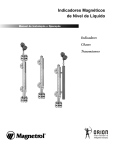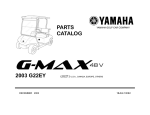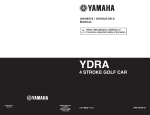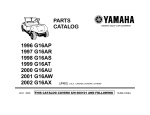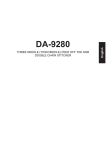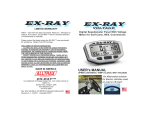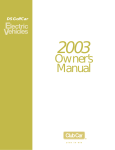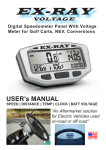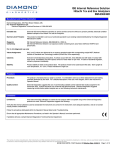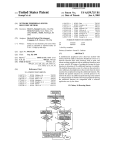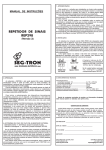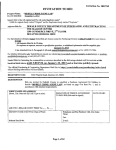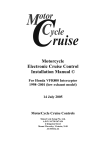Download 2013 YDRE Electric Car Owners Manual
Transcript
OWNER’S / OPERATOR’S MANUAL ! READ THIS MANUAL CAREFULLY! It contains important safety information. YDRE 48 VOLT GOLF CAR Printed in U.S.A 2012-KCC YAMAHA GOLF-CAR COMPANY 1000 HWY 34 East Newnan, GA 30265 770-254-4000 LIT-19626-21-13 JW9-F8199-21 INTRODUCTION Congratulations on your purchase of a Yamaha golf car. This manual contains information you will need for proper operation, maintenance, and care of your golf car. A thorough understanding of these simple instructions will help you to obtain maximum enjoyment from your new Yamaha. If you have any questions about the operation or maintenance of your golf car, please consult a Yamaha dealer. YAMAHA GOLF-CAR COMPANY YDRE OWNER’S/OPERATOR’S MANUAL © 2012 by Yamaha Golf-Car Company 3rd Edition All rights reserved. Any reprinting or unauthorized use without the written permission of Yamaha Golf-Car Company is expressly prohibited. Printed in U.S.A. LIT-19626-21-13 JW9 i IMPORTANT MANUAL INFORMATION Particularly important information is distinguished in this manual by the following notations: This is the safety alert symbol. It is used to alert you to potential personal injury hazards. Obey all safety messages that follow this symbol to avoid possible injury or death. A WARNING indicates a hazardous situation which, if not avoided, could result in death or serious injury. NOTICE TIP Yamaha continually seeks advancements in product design and quality; therefore, while this manual contains the most current product information available at the time of printing, there may be minor discrepancies between your golf car and this manual. If you have any questions concerning this manual, please consult your Yamaha dealer. Read and understand this manual completely before operating your golf car. This manual should be considered a permanent part of your golf car and should remain with the car when resold. A NOTICE indicates special precautions that must be taken to avoid damage to the vehicle or other property. TIP A TIP provides key information to make procedures easier or clearer. ii JW9 CONTENTS WARRANTY 1 IMPORTANT LABELS 2 OPERATOR SAFETY 3 SAFETY CONSIDERATIONS 4 CONTROLS 5 PRE-OPERATION CHECKS 6 OPERATION 7 MAINTENANCE 8 1 STORAGE 9 SPECIFICATIONS 10 WIRING 11 JW9 iii WARRANTY LIMITED 4-YEAR GOLF CAR LIMITED WARRANTY 1 2 3 4 5 6 7 8 9 10 11 Yamaha Golf-Car Company hereby warrants that any new YDRA gas or YDRE electric Yamaha golf car purchased from an authorized Yamaha golf car dealer in the United States will be free from defects in material and workmanship for FOUR years from date of purchase, subject to the stated limitations. DURING THE PERIOD OF WARRANTY any authorized Yamaha golf car dealer will, free of charge, repair or replace, at Yamaha’s option, any part adjudged defective by Yamaha due to faulty workmanship or material from the factory. Parts used in warranty repairs will be warranted for the balance of the vehicle’s warranty period. All parts replaced under warranty become property of Yamaha Golf-Car Company. GENERAL EXCLUSIONS from this warranty shall include any failures caused by: a. Abnormal strain, neglect, or abuse, including lack of proper maintenance, and use contrary to the Owner’s/Operator’s Manual instructions. b. Accident or collision damage. c. Installation of parts or accessories that are not original equipment. d. Fading, rust, or deterioration due to exposure or ordinary wear and tear. e. Modifications or alterations that affect the car’s condition, operation, performance, or durability, or which makes the car serve a purpose other than use as a two-person, golf course vehicle. f. Damage due to improper transportation. g. Acts of God, i.e. lightning, hail damage, flooding, fire, etc. WARRANTY COVERAGE: Year 1: The first year of warranty shall cover the entire vehicle except for the Specific Exclusions below. Year 2: The second year exclusions are the YDRA battery, body parts, seats, mats, bumper assembly, bag carrier, scorecard holder, trim, and the Specific Exclusions below. Year 3: The third year exclusions include the second year exclusions, plus the control cables and electrical system (except electronic speed controller, battery charger, and electric motor), and the Specific Exclusions below. Year 4: The fourth year of the warranty covers only the electric motor, speed controller, battery charger, and transaxle on the YDRE and the engine, clutch system (except drive belt), and transaxle on the YDRA. SPECIFIC EXCLUSIONS: Specific exclusions from this warranty shall include the following: • Electric car batteries, which are covered under a separate warranty. • Any parts replaced due to normal wear or routine maintenance, including oil and air filter elements, tire wear, spark plugs, starter and clutch drive belts. 1-1 • • Any charges incurred in transporting a golf car or charger to and from an authorized Yamaha golf car dealer for service or in performing field service are also excluded from this warranty. Gasoline powered golf car starting batteries on vehicles equipped with a golf course GPS device, or any other device with a parasitic current draw, unless the vehicle is equipped from the factory with an optional deep cycle starting battery. THE CUSTOMER’S RESPONSIBILITY under this warranty shall be to: 1. Operate and maintain the golf car and charger as specified in the appropriate Owner’s/Operator’s Manual; 2. Give notice to an authorized Yamaha golf car dealer of any and all apparent defects within ten (10) days after discovery, and make the vehicle or charger available at that time for inspection and repairs by the dealer’s authorized representative. WARRANTY TRANSFER: Any transfer of warranty must take place within the first three years of the original in-service date of the vehicle. The vehicle must be re-registered by an authorized Yamaha GolfCar Dealer within 30 days of transfer. A fee may be charged for the transfer of the warranty. YAMAHA GOLF-CAR COMPANY MAKES NO OTHER WARRANTY OF ANY KIND, EXPRESSED OR IMPLIED. ALL IMPLIED WARRANTIES OF MERCHANTABILITY AND FITNESS FOR A PARTICULAR PURPOSE WHICH EXCEED THE OBLIGATIONS AND TIME LIMITS STATED IN THIS WARRANTY ARE HEREBY DISCLAIMED BY YAMAHA GOLF-CAR COMPANY AND EXCLUDED FROM THIS WARRANTY. SOME STATES DO NOT ALLOW LIMITATIONS ON HOW LONG IMPLIED WARRANTY LASTS, SO THE ABOVE LIMITATION MAY NOT APPLY TO YOU. ALSO EXCLUDED FROM THIS WARRANTY IS ANY INCIDENTAL OR CONSEQUENTIAL DAMAGES INCLUDING LOSS OF USE. SOME STATES DO NOT ALLOW THE EXCLUSION OR LIMITATION OF INCIDENTAL OR CONSEQUENTIAL DAMAGES, SO THE ABOVE EXCLUSION MAY NOT APPLY TO YOU. THIS WARRANTY GIVES YOU SPECIFIC LEGAL RIGHTS, AND YOU MAY ALSO HAVE OTHER RIGHTS, WHICH VARY, FROM STATE TO STATE. Yamaha Golf-Car Company, NEWNAN, GEORGIA 30265-1320 EFFECTIVE DATE: 6/1/11 LIT-13710-01-12 JW9 WARRANTY YAMAHA FOUR-YEAR LIMITED WARRANTY FOR TROJAN BRAND ELECTRIC GOLF CAR AND UTILITY VEHICLE BATTERIES WHEN CHARGED WITH A YAMAHA SUPPLIED 48-VOLT CHARGER YAMAHA Golf-Car Company (herein referred to as “YGC”) hereby warrants to the Original Retail Purchaser or Lessee of a YAMAHA YDRE golf car or PTV, U-MAX or Adventurer utility vehicle, or YAMAHA transportation or specialty vehicle purchased from an Authorized YGC Dealer, that the Trojan batteries charged with a YAMAHA supplied battery charger will be free from defects in materials and workmanship, and will provide “36-hole performance” for a period of four-years or “1,000 rounds” from the date of purchase, whichever event occurs first, subject to the terms and conditions contained herein. This limited warranty covers defects in materials and workmanship only for a period of four-years or “1,000 rounds”, as applicable, from date of purchase, whichever event occurs first. The terms of this FOUR-YEAR LIMITED WARRANTY shall be to furnish one or more replacement batteries within the four-year period or before 20,000 amp-hours are discharged, whichever event occurs first, as determined by YGC using the information recorded and stored in the Genius controller. • This warranty only applies to factory installed Trojan battery sets charged with a Yamaha supplied battery charger. • “1,000 rounds” means 20,000 amp-hours discharged, as recorded in the Genius controller. • The customer must perform (or have a contracted Yamaha Dealer perform) all periodic maintenance and discharge testing as specified in the Yamaha Service Manual Maintenance Schedule. No labor or transportation expenses are included in this limited warranty. Maintenance records must be kept. • Replacement batteries may be of a different brand or capacity, but are warranted to provide 36-hole performance for the remainder of the warranty term. • “36-hole performance” is defined as 60-minutes discharge time as tested and recorded using a Lester model #17770 discharge machine at an ambient temperature of between 60 and 100 degrees F (16 and 38 degrees C). Ambient temperatures between 60 and 80 degrees F (16 and 27 degrees C) must be corrected using the formula: Adjusted Discharge Time = (Discharge Minutes) / (1-(((80-TEMP)/100) x 0.64)). • The customer must notify the Dealer within 10 days that a vehicle has failed to make 36 holes per day. YGC reserves the right to test and recharge any batteries in question. ANY IMPLIED WARRANTY OF MERCHANTABILITY OR FITNESS FOR A PARTICULAR PURPOSE SHALL BE VOID AND EXCLUDED SUBSEQUENT TO ONE YEAR FROM THE DATE OF PURCHASE. THE REPLACEMENT OF THE BATTERY IS THE EXCLUSIVE REMEDY UNDER THIS WRITTEN WARRANTY OR ANY IMPLIED WARRANTY. YAMAHA MAKES NO OTHER REPRESENTATION OR WARRANTY OF ANY KIND, AND NO REPRESENTATIVE, EMPLOYEE, DISTRIBUTOR OR DEALER OF YAMAHA HAS THE AUTHORITY TO MAKE OR IMPLY ANY REPRESENTATION, PROMISE OR AGREEMENT WHICH IN ANY WAY VARIES THE TERMS OF THIS LIMITED WARRANTY. LIMITED WARRANTY EXCLUSIONS Without limiting the generality of the foregoing in any way, and as part of its limited warranty exclusion, YAMAHA does not warrant that its battery is suitable for use in any application other than in a golf car or utility vehicle. As in the use of any battery, a prudent owner will read and study the charger owner’s manual, the vehicle owner’s manual, the operator’s instructions, and the battery warning labels; and will exercise due care in working on or around batteries. THE PROVISIONS OF THIS LIMITED WARRANTY SHALL NOT APPLY IF BATTERIES ARE SUBJECTED TO ANY OF THE FOLLOWING CONDITIONS: • Abuse or neglect such as improper fluid levels, loose wiring, rusted or corroded hardware. JW9 • Lack of proper maintenance as outlined in the electric vehicle Owner’s/Operator’s Manual. For example, lack of regular battery watering or adding water to the battery before charging. • Damage caused by improper installation of the battery. • Neglect, breakage, freezing, fire, explosion, wreckage, the addition of any chemical, or the operation of the battery in an uncharged condition (below half-charge – 1.200 specific gravity). • Battery charged by systems other than the original equipment type battery charger. • On fleet golf cars, the use of any non-YAMAHA supplied electrical devices that consume more than one amp-hour per round or two amp-hours per day of battery energy. Examples of these devices include, but are not limited to: heating or cooling systems; GPS (global position system) devices; information gathering devices; lights; radios or stereos; or yardage measuring devices. • Less than one charger per car or inadequate facility electrical power to power all chargers. Examples include more than one charger on a single circuit, circuit rating of less than 15 amps, or not enough circuits for the number of cars. • In fleet applications, less than one battery charger per vehicle. For example, using only 10 battery chargers to charge a 15 car fleet. • The use of any system that does not allow the battery chargers to shut off automatically. For example, timer systems that are designed to switch battery charger AC power on and off during peak demand hours. THIS BATTERY IS INTENDED TO BE USED BY PERSONS WITH TRAINING AND EXPERIENCE WITH BATTERIES AND ONLY IN YAMAHA ELECTRIC VEHICLES. ANY OTHER USE RENDERS THE LIMITED WARRANTIES EXPRESSED HEREIN AND ALL IMPLIED WARRANTIES NULL AND VOID AND SAME ARE HEREBY EXCLUDED. ALSO EXCLUDED FROM THIS LIMITED WARRANTY ARE ANY AND ALL INCIDENTAL OR CONSEQUENTIAL DAMAGES INCLUDING, BUT NOT LIMITED TO, LOSS OF USE OR REVENUE, LOSS OF TIME, INCONVENIENCE OR ANY OTHER ECONOMIC LOSS. Some states do not allow limitation on the duration of an implied warranty, exclusions or limitations of incidental or consequential damages. Therefore, the above limitations or exclusions may not apply to you. WARRANTY LIMITATIONS Yamaha Golf-Car Company’s and Trojan Battery Company’s limit of liability shall be to replace a defective battery. Replacement shall mean furnishing a new battery or used battery with sufficient life to complete the remainder of the warranty term, which is identical or reasonably equivalent to the warranted product at no cost to the purchaser during the limited warranty period, except for labor or transportation expenses. Damage not resulting from a defect in materials or workmanship or which occurs due to abuse or neglect (including failure to provide reasonable and necessary maintenance), accident, alteration or acts of God is excluded from this limited warranty. This warranty gives you specific legal rights, and you may also have other rights, which vary from state to state. For further information or to submit a warranty claim, contact your local Yamaha Golf-Car Dealer or contact Yamaha Golf-Car Company toll free at (877) 811-8250. Yamaha Golf-Car Company, NEWNAN, GEORGIA 30265-1320 EFFECTIVE DATE: 06/01/11 LIT-13710-EL-11 1-2 1 2 3 4 5 6 7 8 9 10 11 IMPORTANT LABELS SAFETY AND INSTRUCTION LABELS 1 2 3 Read the following labels carefully before operating your golf car, and promptly replace any labels which become damaged or removed. Death or serious personal injury can result from failing to comply with the safety and warning instructions affixed to the golf car or utility vehicle. 4 1 3 5 4 5 2 6 7 Y-924ff 8 9 1 10 11 Y-500c 2-1 JW9 JW9 3 2 • Causer une decharge totale de la batterie et endommager la batterie pendant l’entreposage a long terme. • Apres avoir change l’interrupteur de position “RUN” a position “TOW”, attendre un minimum de 15 seconds avant de le remettre. JW9-K8298-10 NOTICE / NOTIFICATION Mettre l’interrupteur a position “TOW” avant de remorquer avant l’entreposage. Non-observation pourrait: TOW SWITCH ou • Dommages de système d’entrainement en remourquant. Move switch to the “TOW” position before towing or storage. Failure to do so may lead to: • Drive system damage when towing. • Complete battery discharge and battery damage when storing long term. • After moving switch from “RUN” to “TOW”, wait 15 seconds minimum before switching again. 4 IMPORTANT LABELS 2-2 1 2 3 4 5 6 7 8 9 10 11 5 6 7 8 9 10 11 YEAR OF CONSTRUCTION: 20XX YAMAHA MOTOR POWERED PRODUCTS CO., LTD. 200-1 SAKAGAWA, KAKEGAWA, JAPAN MAX. BATTERY WEIGHT: XXX kg 2 3 4 5 2-3 Y-1607f MODEL: YDREX MAX. POWER: X.X KW WEIGHT (NO BATT): XXX kg JXX-F4236-XX IMPORTANT LABELS 1 JW9 IMPORTANT LABELS GOLF CAR SERIAL NUMBER 1 1 The golf car serial number 1 is identified in the location shown. 2 JWX-000000 TIP Y-1539B The first three digits of the serial number are for model identification; the remaining digits are the unit production number. Keep a record of these numbers for reference when ordering parts from a Yamaha Golf-Car Company dealer. 3 4 5 6 7 8 9 10 11 JW9 2-4 ! OPERATOR SAFETY Yamaha golf cars are designed to be simple to operate. However, be sure to observe the following to reduce the risk of serious injury or death due to loss of control and other hazards: 1 2 BEFORE OPERATING THE GOLF CAR 3 l 4 l 5 l 6 l 7 l 8 l 9 Y-68 Read this Owner’s/Operator’s manual and all safety and instruction labels on the golf car before operating. Perform the pre-operation checks found in Section 6 of this manual. Only authorized people should drive the golf car, from the driver’s side only, and only in designated areas. Do not allow more than two occupants per seat. This golf car is restricted to two occupants unless equipped with a rear seat. Do not operate the golf car while under the influence of alcohol or drugs; their effect on vision and judgment make operating a golf car dangerous. Do not operate the golf car on public streets, roads or highways unless allowed by law or local regulating authority. 10 WHILE OPERATING THE GOLF CAR 11 l Y-928 l l 3-1 Keep your entire body inside the golf car, remain seated, and hold on when the car is in motion. Do not start the golf car until all occupants are seated. Keep your hands on the steering wheel and your eyes on the path ahead. JW9 ! OPERATOR SAFETY l Use extra care in congested areas or when backing up. Always back up slowly, and watch carefully. l Avoid starting or stopping abruptly. l Vary the speed of the golf car to match the terrain of the course. l Avoid turning the steering wheel too sharply at higher speeds to avoid tipping or rolling the golf car. l Always drive slowly straight up or straight down slopes – never at an angle to avoid tipping or rolling the golf car. 1 2 3 4 5 Y-921 l 6 Do not run the engine indoors. Exhaust gas is poisonous and could result in carbon monoxide poisoning. 7 8 Y-922 9 l Do not make any modification or addition which affects capacity or safe operation, or make any changes not in accordance with the owner’s/operator’s manual. 10 11 Y-923 JW9 3-2 ! SAFETY CONSIDERATIONS 1 2 3 4 5 6 7 8 9 10 11 Like all machines, golf cars can cause injury if improperly used or maintained. This section contains broad safety practices required for safe golf car operation. Before golf cars are operated, golf course personnel should establish any additional safety practices that may be required for safe operation. Experience has shown that golf cars are safe when operated in accordance with the safety warnings affixed to every golf car. This safe operation is enhanced when golf cars are used according to the safety rules and practices established to meet the terrain and conditions of the course they are used on. The information contained here is intended for golf course personnel responsible for golf car safety. If you are responsible for the operation and maintenance of this golf car, we encourage you to implement this golf car safety program. Do not operate golf cars when under the influence of alcohol or drugs. Death or serious personal injury can result from failing to comply with the safety and warning instructions affixed to the golf car or utility vehicle. GOLF COURSE SAFETY SURVEY Perform safety surveys regularly to identify hazardous areas where golf cars should not be operated. GOLF COURSE HAZARD PREVENTION The following golf course hazards must be made safe: l DRIVER QUALIFICATIONS Allow only authorized people to operate golf cars. It is recommended that only people who possess a valid motor vehicle driver’s license be allowed to operate golf cars. Place operation and safety instructions recommended by the golf car manufacturer, along with the golf course safety rules, in a conspicuous place near the golf car rental area or golf car pick-up area. It is also recommended that the following warning be posted in a conspicuous location: 4-1 Steep Grades. Where steep grades exist, restrict golf cars to designated golf car pathways where possible. In addition, identify steep grades with a suitable warning like: Descend steep grades slowly with foot on brake. Death or serious personal injury can result from failing to comply with the safety and warning instructions affixed to the golf car or utility vehicle. l Sharp Turns, Blind Corners, Bridge Approaches. Chain or rope off these potentially hazardous areas or identify them with a suitable warning describing the nature of the hazard and the proper precautions to be taken to avoid the hazard. JW9 ! SAFETY CONSIDERATIONS l l l Wet Areas. Wet grass may cause a golf car to lose traction and may affect stability. Golf car operators should reduce speed in wet areas or during periods of inclement weather. Loose Terrain. Loose terrain may cause a golf car to lose traction and may affect stability. Repair loose terrain, chain or rope off these areas, or identify loose terrain with a suitable warning. Golf Car and Pedestrian Interference. Reroute golf car traffic or pedestrian traffic in congested areas wherever possible to prevent accidents. If it is impractical to reroute traffic, erect warning signs to warn pedestrians of golf car traffic, and to warn golf car operators to drive slowly, use caution, and watch for pedestrians. MAINTENANCE REQUIRED FOR GOLF CAR SAFETY Practice the following to help ensure the safety of golf car operators: l l l Parts and Materials. Use only replacement parts and materials recommended by the manufacturer. l Ventilation. Properly ventilate all maintenance and storage areas in accordance with applicable fire codes and ordinances to avoid fire hazards. Ventilation is required to remove flammable vapors and fumes from gasoline powered car storage areas. Ventilation is also required to remove hydrogen gas from the car storage areas during the battery charging process. For electric powered golf cars, the amount of hydrogen gas emitted during charging depends on a number of factors, such as the condition of the batteries, the output rate of the battery charger, and the amount of time the batteries are on charge. Because of the highly volatile nature of hydrogen gas and its propensity to rise and accumulate at the ceiling in pockets, a minimum of 5 air changes per hour is recommended. Consult applicable fire and safety codes for the specific ventilation levels requirement, as well as requirements for the use of explosion proof electrical apparatus. Preventative Maintenance. Perform all scheduled maintenance in accordance with manufacturer’s recommendations to provide the golfing patron with a safe, properly operating golf car. 2 3 4 5 6 7 8 9 10 11 Personnel. Allow only qualified, trained, and authorized personnel to inspect, adjust, and maintain golf cars. JW9 1 4-2 ! SAFETY CONSIDERATIONS 1 2 3 4 SAFETY PRECAUTIONS DURING MAINTENANCE When performing maintenance, follow all safety instructions contained in the manufacturer’s operation and service manuals, as well as the following safety procedures: l Properly immobilize golf car before beginning any maintenance to avoid any unexpected vehicle movement. l Properly block chassis before working underneath golf car to avoid any unexpected vehicle movement. l When working on the fuel system or the battery, do not smoke, or allow any sparks or open flames near the vehicle, to avoid any fires or explosions. l Before working on an electric golf car, disable the car’s electrical system in accordance with the manufacturer’s instructions to avoid electrical shock or damage to the electrical system. 5 6 7 8 l Use only properly insulated tools when working on electrically powered golf cars or around batteries to avoid electrical shock or damage to the electrical system. l Maintain all safety devices including brakes, steering mechanisms, warning devices, and governors, in a safe operating condition. Do not modify these safety devices as supplied by the manufacturer. 9 10 11 After each maintenance or repair, the car must be driven by a qualified, trained, and authorized person – in an area free of pedestrian traffic – to ensure proper operation and adjustment. 4-3 l l Record all maintenance performed in a maintenance record log by date, name of person performing maintenance, and type of maintenance. Periodically inspect maintenance log to ensure accurate and complete entries. l Provide operator comment cards to assist in identifying non-periodic maintenance needs for specific golf cars. l Maintain in a legible condition all nameplates, warnings, and instructions provided by the manufacturer. l If new nameplates, warnings, or instructions are needed, contact your Yamaha Golf-Car Company dealer. STORAGE AND BATTERY CHARGING Take the following precautions to ensure maintenance worker safety: l Only use battery charging facilities and procedures that are in accordance with applicable ordinances and regulations to avoid explosions, electrical shock or damage to the electrical system. l Periodically inspect charging facilities and procedures to be certain that applicable safety codes, regulations, and procedures are being followed to avoid any fires or explosions. JW9 CONTROLS FEATURES 4 6 5 3 2 1 Y-916ee 1 1 Brake pedal 2 Parking brake pedal 3 Accelerator pedal 4 Steering wheel 5 Main switch 6 Drive select switch 7 Batteries 8 Seat 9 Front body a Front tire b Front bumper c Rear body d Rear tire e Rear bumper f Tow switch g Receptacle 2 3 4 5 6 7 Y-935 7 8 8 12 9 9 16 11 14 10 13 Y-919a Y-918dd 11 15 Y-930a JW9 10 5-1 CONTROLS MAIN SWITCH 1 The main switch controls the following items: 2 OFF REV ON FWD 3 4 “OFF” All electrical control circuits are switched off (controller remains energized). The golf car cannot be operated. The key can be removed only in this position. Y-912 5 OFF REV FWD ON “ON” Electrical circuits are switched on. The golf car can be driven. 6 7 Y-913 8 9 10 11 5-2 JW9 CONTROLS OFF REV ON FWD Y-904 DRIVE SELECT SWITCH The drive select switch is used to shift the golf car into forward or reverse. After coming to a complete stop, move the lever to the desired position. Switch Position Car Movement FWD FORWARD REV REVERSE 1 2 3 4 TIP The reverse alarm will sound when the drive select switch is turned to “REV.” BEEP 5 6 Y-920 7 ACCELERATOR PEDAL A The accelerator pedal controls the golf car’s speed. Action Car Speed Depress pedal Increase Release pedal Decrease 8 9 Y-20A 10 å Accelerator pedal BRAKE PEDAL 11 Press down on the brake pedal to stop the golf car. B ∫ Brake pedal Y-21a JW9 5-3 CONTROLS PARKING BRAKE PEDAL 1 Press down on the parking brake pedal whenever parking the golf car. 2 C ç Parking brake pedal Y-22a 3 TIP Release the parking brake by depressing the accelerator pedal. 4 5 The parking brake will automatically release when the accelerator pedal is depressed. If the main switch is in the “ON” position, depressing the accelerator may suddenly cause the golf car to move. Death or serious personal injury can result from failing to comply with the safety and warning instructions affixed to the golf car or utility vehicle. 6 7 8 9 10 11 5-4 JW9 CONTROLS TOW SWITCH A 1 2 å Tow switch RUN TOW Before operating the car, make sure the tow switch is in the “RUN” position. 3 NOTICE Y-1995 Ensure that the “Drive Select Switch” is in the “FWD” position and then move the “TOW Switch” to “TOW” before towing. After moving switch from “RUN” to “TOW,” wait 15 seconds minimum before switching again. Failure to do so may lead to drive system damage while towing. 4 5 6 7 8 9 10 11 JW9 5-5 PRE-OPERATION CHECKS Pre-operation checks should be made each time you use your golf car. Get in the habit of performing the following checks in the same way so that they become second nature. 1 2 3 To keep car from moving while performing pre-operation checks: l Remove main switch key. l Apply parking brake. Death or serious personal injury can result from failing to comply with the safety and warning instructions affixed to the golf car or utility vehicle. 4 5 6 PRE-OPERATION CHECKLIST 7 Before each use check the following: 4 Batteries 4 Tire condition 4 Steering system 4 Reverse alarm 4 Pedal operation 4 Body and chassis 8 9 SEAT 10 Open the seat for checking and servicing. 11 Y-905 6-1 JW9 PRE-OPERATION CHECKS BATTERIES 1 Check that the batteries are held securely in place to prevent them from being damaged from vibration or jarring. Also check that no battery caps are missing to prevent battery acid from spilling from the batteries. Check the battery terminals for corrosion. Battery electrolyte is poisonous and dangerous, causing severe burns, etc. It contains sulfuric acid. Avoid contact with skin, eyes or clothing. Ventilate when charging or using in enclosed space. Always shield eyes when working near batteries. KEEP OUT OF REACH OF CHILDREN. 2 3 4 5 6 7 TIRE CONDITION Tire Air Pressure 8 Check the tire air pressure before operating the golf car. Tire pressure: 138 kPa, 1.4 kgf/cm2 (20 psi) Y-30 9 10 Tire Wear Limit Check the tire surface for damage, cracks or embedded objects. When tire tread wears down to 1 mm (0.04 in.), replace the tire. A å Wear limit Y-31 JW9 6-2 11 PRE-OPERATION CHECKS STEERING SYSTEM 1 Check the steering system for excessive free play by: 2 3 Y-932g 4 l moving the steering wheel up and down, and back and forth. l turning the steering wheel slightly to the right and left. If you feel excessive free play, or hear rattling sounds which may indicate loose steering components, consult a Yamaha dealer. OFF 5 REV ON FWD REVERSE ALARM Check the reverse alarm by moving the drive select switch to “REV” for reverse. The alarm should sound. 6 7 Y-911b PEDAL OPERATION 8 Check the following pedal controls for proper operation. If a pedal does not work properly, consult a Yamaha dealer. 9 Accelerator Pedal 1. WARNING! Make sure the main switch is in the “OFF” position. 2. Make sure the accelerator pedal operates smoothly. A 10 11 å Accelerator pedal Y-20A 6-3 JW9 PRE-OPERATION CHECKS Brake Pedal 1 Make sure the brake pedal feels firm when pressed and returns to its original position when released. 2 ∫ Brake pedal B Y-21a 3 Parking Brake Pedal Make sure the parking brake pedal locks in place with a positive click, and releases when the accelerator pedal is pressed. 4 5 ç Parking brake pedal TIP C Y-22a 6 Release the parking brake by depressing the accelerator pedal. 7 BODY AND CHASSIS Before each use, visually inspect the golf car body and chassis for damage and/or missing parts. 8 9 10 11 JW9 6-4 OPERATION STARTING OFF 1 REV ON FWD 2 1. With the parking brake applied, turn the drive select switch to “FWD” for forward, or “REV” for reverse. NOTICE 3 Y-933 4 Do not shift from “FWD” forward to “REV” reverse while the golf car is moving. Transmission damage can result. OFF REV ON FWD 2. Turn the main switch to “ON.” 5 6 Y-911b 7 8 Do not depress the accelerator pedal when turning on the main switch or the golf car may start moving unexpectedly. Death or serious personal injury can result from failing to comply with the safety and warning instructions affixed to the golf car or utility vehicle. 3. Check that your path is clear in the direction you plan to go, and slowly depress the accelerator pedal. The golf car will start to move. A 9 å Accelerator pedal 10 Y-20A TIP The parking brake automatically releases when the accelerator pedal is depressed. 11 7-1 JW9 OPERATION STOPPING 1 To stop the golf car, gradually press down on the brake pedal. 2 å Brake pedal B NOTICE A Y-65c Do not hold the golf car on an incline with the accelerator – use the brake. Transmission damage can result. When the car has come to a stop, apply the parking brake pedal and turn the main switch to “OFF.” ∫ Parking brake pedal 3 4 5 6 7 8 9 10 11 JW9 7-2 MAINTENANCE 1 PERIODIC MAINTENANCE CHARTS Regular maintenance is required for the best performance and safe operation of your golf car. 2 3 4 Be sure to turn off the main switch and apply the parking brake when you perform maintenance, unless otherwise specified. If the owner is not familiar with servicing the machine, death or serious personal injury can result. When in doubt the work should be done by a Yamaha dealer or other qualified mechanic. CS - CHECK CA - CHECK AND ADJUST R - REPLACE Remarks 5 PRE-OP 6 7 8 9 10 EVERY MONTH Daily PreOperation S - SERVICE Page Charge S S S S S S 4-3/ 8-5 Clean battery tops, check for tightness of hold-down screws and terminals S S S S S S 6-2/ 8-3 Check brake pedal freeplay and adjust if necessary CS CA CA CA CA CA 6-4/ 8-10 Check steering operation CS CS CS CS CS CS 6-3 Check tire pressure, tread depth, tire surface for damage CS CA CA CA CA CA 6-2 Check body and chassis for damage CS CS CS CS CS CS 6-4 Check tightness of all bolts, nuts, screws and rivets CS CS CS CS CS CS * Check reverse alarm operation CS CS CS CS CS CS 6-3 Check electrolyte level CS CS CS CS CS 8-3/8-4 Check for loose or broken connections CS CS CS CS CS Clean/Lube pedal control area CL EVERY 6 Check all wire insulation for cracks MONTHS and/or worn spots Check shock absorbers for oil leaks and damaged springs 11 CL - CLEAN AND LUBRICATE L - LUBRICATE 40 rounds 250 rounds 500 rounds 1000 rounds 2000 rounds 250 hrs 500 hrs 125 hrs 20 hours 1000 hrs 1200 mls 2500 mls 600 mls 100 miles 5000 mls 2000 kms 4000 kms 1000 kms 160 kms 8000 kms (Every (Every 2 (Every 6 (Every (Every 4 Year) years) months) Month) years) * — CS CS CS CS * CS CS CS CS * * Items without a page number reference should be serviced by a Yamaha dealer or other qualified mechanic. This manual does not contain these procedures. They are contained in the Service Manual. 8-1 JW9 MAINTENANCE CS - CHECK CA - CHECK AND ADJUST Remarks EVERY YEAR R - REPLACE Daily PreOperation S - SERVICE CL - CLEAN AND LUBRICATE L - LUBRICATE 40 rounds 250 rounds 500 rounds 1000 rounds 2000 rounds 250 hrs 500 hrs 125 hrs 20 hours 1000 hrs 1200 mls 2500 mls 600 mls 100 miles 5000 mls 2000 kms 4000 kms 1000 kms 160 kms 8000 kms (Every (Every 2 (Every 6 (Every (Every 4 Year) years) months) Month) years) Perform a discharge test S S S * Apply Terminal protectant S S S — Check rear axle bearing play for roughness or freeplay CS CS CS * Check steering knuckle bushing freeplay / Adjust wheel alignment CA CA CA * Check wheel nut tightness, front wheel bearing play CS CS CS * Check transaxle oil level and inspect for leakage CS CS CS 8-9 Check pedal stop operation and adjust if necessary CA CA CA * EVERY 2 YEARS Replace transaxle oil EVERY 4 YEARS Inspect internal wet brake and replace pads if necessary R 1 Page 2 3 4 5 * CA * * Items without a page number reference should be serviced by a Yamaha dealer or other qualified mechanic. This manual does 6 not contain these procedures. They are contained in the Service Manual. 7 8 9 10 11 JW9 8-2 MAINTENANCE Battery Care 1 Battery electrolyte is poisonous and dangerous, causing severe burns, etc. It contains sulfuric acid. Avoid contact with skin, eyes, or clothing. Antidote: EXTERNAL: Flush with water. INTERNAL: Drink large quantities of water or milk. Follow with milk of magnesia, beaten egg, or vegetable oil. Call physician immediately. EYES: Flush with water for 15 minutes and get prompt medical attention. Batteries produce explosive gases. Keep sparks, flame, cigarettes, etc., away. Ventilate when charging or using in enclosed space. Always shield eyes when working near batteries. KEEP OUT OF REACH OF CHILDREN. 2 3 4 5 6 7 8 Six 8-volt deep cycle batteries provide power for your electric golf car and must be properly maintained and recharged for maximum performance and service life. To maintain your batteries: 1. Clean the tops of the batteries with a solution of baking soda and water, as necessary, to remove corrosion. 9 10 11 NOTICE Do not allow cleaning solution to enter battery cells. Serious battery damage can result. 2. Check the fluid level before and after charging. 8-3 JW9 MAINTENANCE Fill Well Electrolyte 1/8” Below Bottom of Fill Well Max. Level charged battery Electrolyte 1/8” (3 mm) l Before charging: only add distilled water if fluid is below the top of the plates, and then add just enough to cover plates. l After charging: open the vent caps and look inside the fill wells. Add distilled water until the electrolyte level is 3 mm (1/8") below the bottom of the fill well. A piece of rubber can be used safely as a dipstick to help determine this level. Clean, replace and tighten all vent caps. Max. Level discharged battery NOTICE 3. Using a hydrometer, check the specific gravity of the battery fluid in each cell against the readings on the chart below. Consult a Yamaha dealer if any low readings are found, or if readings vary more than one point between cells. Temperature °C °F Satisfactory Uncorrected Hydrometer Reading 48.9 120 1.244 43.3 110 1.248 37.8 100 1.252 3 4 32.2 90 1.256 26.7 80 1.260 21.1 70 1.264 15.6 60 1.268 10.0 50 1.272 4.4 40 1.276 -1.1 30 1.280 6 7 8 9 10 11 Y-936a JW9 2 5 Normal tap water contains minerals which are harmful to a battery; therefore, refill only with distilled water. Y-937c 1 8-4 MAINTENANCE Battery Charging 1 Read and understand the owner’s manual provided with your golf car’s battery charger before charging batteries. Death or serious personal injury can result from failing to comply with the safety and warning instructions affixed to the golf car or utility vehicle. 2 3 4 Explosive hydrogen gas is produced while batteries are being charged. Only charge batteries in well ventilated areas (a minimum of five air changes per hour is recommended). Death or serious personal injury can result from failing to comply with the safety and warning instructions affixed to the golf car or utility vehicle. 5 6 7 8 OFF REV FWD ON 9 To charge the batteries in your golf car, follow the instructions contained in your battery charger’s owner’s manual. The following is a summary of the charging steps. 1. Turn main switch key to “OFF” position. 10 Y-912 NOTICE Always put the tow switch in the “TOW” position before charging battery or damage to the electrical system may result. 11 2. Lift up the seat and move the tow switch to the TOW position. 8-5 JW9 MAINTENANCE NOTICE Use only battery chargers that are rated for use with 48-volt Yamaha Golf Cars. Serious battery damage can result. Thoroughly read and understand the user manual supplied with your 48-volt charger. 3. With the charger properly connected and grounded (see charger’s owner’s manual), insert the DC output into the golf car receptacle. Y-669c POWER ON A ERROR1 B ERROR2 C CHARGING 90% CHARGED D E Do not disconnect the DC output cord from the battery receptacle when the charger is on or an arc could occur that may cause an explosion. Death or serious personal injury can result from failing to comply with the safety and warning instructions affixed to the golf car or utility vehicle. å ∫ ç ∂ fl Power ON Light (Red) Error Light 1 (Red) Error Light 2 (Red) Charging Light (Yellow) Charged Light (Green) 4. When the charger is plugged into the AC power, the Power ON Light illuminates continuously. 5. If Error 1 or Error 2 light is blinking, there is a problem with the batteries or the charger. Contact your Yamaha Dealer. Y-1559 JW9 6. During normal charging, the Charging Light blinks or continually illuminates. 7. The charger turns off automatically when the batteries reach full charge. 8-6 1 2 3 4 5 6 7 8 9 10 11 MAINTENANCE 8. After the charger has turned off, disconnect the DC output plug from the golf car receptacle by grasping the plug body and pulling the plug straight out of the receptacle. 1 2 Battery Installation 3 When working with batteries, do not put wrenches or other metal objects across the battery terminals. An arc can occur causing an explosion or fire at the battery. Death or serious personal injury can result from failing to comply with the safety and warning instructions affixed to the golf car or utility vehicle. 4 5 6 C B A Y-751D 7 1. Install the battery holddown plates and torque to 7-9 Nm, 0.70.9 m•kg (62-80 in•lb) as shown. å Forward ∫ Battery ç Battery holddown plate 8 2. Connect the wire leads and torque to 9-10 Nm, 0.9-1.0 m•kg (80-89 in•lb) as shown. 9 10 Y-672h 11 8-7 When installing batteries: l Carefully place battery cables and hold-downs making sure that cables do not lay across vent caps. l Always remove the negative (–) cable to the motor controller first, and install it last. A spark can occur causing an explosion or fire at the battery. Death or serious personal injury can result from failing to comply with the safety and warning instructions affixed to the golf car or utility vehicle. JW9 MAINTENANCE NOTICE 1 Do not overtighten the battery holddown nuts. Excessive force will damage the battery casing. 2 Fuse Replacement 3 B A Y-523a Be sure to use the specified fuse. Using a wrong fuse can cause electrical system damage and create a fire hazard. Death or serious personal injury can result from failing to comply with the safety and warning instructions affixed to the golf car or utility vehicle. 4 5 6 Fuse Type: 3 Amp, Blade Style NOTICE 7 When replacing a fuse be sure the main switch is turned off to prevent accidental shortcircuiting and electrical system damage. 8 1. Locate the in-line fuse holder on the main wire harness adjacent to the tow switch. 2. Pull fuse holder cover off. 9 10 3. Pull fuse out, inspect and replace if necessary. 11 å Fuse holder ∫ Fuse JW9 8-8 MAINTENANCE Transaxle Oil 1 To check transaxle oil level: 1. Place the golf car on a flat, level surface. 2 3 1 3 2. Remove seven plastic rivets 1 and two bolts 2, and remove the bag holder insert 3. 3. Place an oil pan under the transaxle case. 2 4. Clean area around servicing plug 4. 4 5 Y-1994 5. Using an 8 mm hex wrench, remove transaxle oil servicing plug located on the rear of the transaxle case. 6. Transaxle oil should be at the top of the oil servicing hole or just beginning to run out of hole. 6 NOTICE 4 Do not allow foreign material to enter transaxle. Serious transaxle damage can result. 7 8 Y-1214 9 7. If needed, add Yamalube Friction Modified Shaft Drive Gear Oil until it is at the top of the plug hole or just beginning to run out of servicing hole. TIP The YDRE Golf Car is equipped with an internal wet brake. Use of oil other than Yamalube Friction Modified Shaft Drive Gear Oil will cause brake noise. 10 11 8. Install the transaxle servicing plug and tighten to 14-19 Nm, 1.4-1.9 m•kg (120-168 in•lb). 9. Install the bag holder insert 3 and secure with two bolts 2 and seven plastic rivets 1. 8-9 JW9 MAINTENANCE TIP For transaxle oil replacement, consult a Yamaha dealer or other qualified mechanic. 1 2 NOTICE Before performing wheel or brake maintenance, verify that the main switch is in the “OFF” position. Serious transaxle damage can result. Y-57 3 4 Wheel Replacement To remove and install a wheel on your golf car: 1. With the wheels blocked to prevent the golf car from moving, loosen the wheel nuts. 2. Elevate the golf car with a jack and remove the wheel nuts and the wheel. 3. Reverse the removal steps when installing the wheel. Wheel nut tightening torque: 80 Nm, 8.0 m.kg (58 ft.lb) 5 6 7 8 Brake Adjustment The brakes on your golf car are self-adjusting. Before you operate the car, press down on the brake pedal several times to make sure the brakes are functioning properly. 9 10 11 Consult your Yamaha dealer before using your golf car if you suspect brake problems. Death or serious personal injury can result from failing to comply with the safety and warning instructions affixed to the golf car or utility vehicle. JW9 8-10 MAINTENANCE Brake Pedal Free Play Adjustment 1 NOTICE 2 Before adjusting brake pedal free play, pump the brake pedal several times to self-adjust the brakes. 3 To adjust the brake pedal free play: 1. Remove the floor mat and service lid from the floor of the golf car. 4 5 6 Y-61c 7 a 8 8 9 10 11 12 13 14 15 16 17 2. Check the brake pedal free play by pressing against the pedal with two fingers (using light force) and measuring the distance the pedal travels before resistance is felt. 18 Brake pedal free play Å: 45-50 mm (1.77-1.96 in.) 7 9 Y-62b 10 A B 11 3. If the free play distance needs adjusting, loosen the lock nut å (under rubber bushing) and turn the adjusting nut ∫ in or out until free play specification is met. Then tighten the lock nut in place. NOTICE Y-909D 8-11 Do not over-tighten the brake cables. Over-tightening will increase brake wear and affect overall performance of car. Premature brake wear can result. JW9 STORAGE Perform the following preparations when storing your golf car for extended periods of time: TIP Turn main switch key to “OFF” position, lift seat and switch tow switch in the “TOW” position. Remove key from main key switch, and store key in a safe place. CHASSIS PREPARATION 1. Verify the tire pressure is set to 138 kPa, 1.4 kgf/cm2 (20 psi). 2. Have the batteries recharged every 60-90 days to keep them fully charged. The batteries must be kept fully charged to avoid damage. 1 2 NOTICE Do not allow cleaning solution to enter battery cells. Serious battery damage can result. 3 3. Clean the top of the batteries with a solution of baking soda and water, as necessary, to remove corrosion. 4 5 2. Clean exterior of the golf car and apply a rust inhibitor. 6 3. Cover the golf car with a breathable cover and store it in a dry, well-ventilated area. 7 BATTERY PREPARATION 8 1. Remove the batteries from the golf car and store them in a cool, dry place that stays between 0°C (32°F) and 30°C (90°F). 9 10 11 JW9 9-1 SPECIFICATIONS 1 GENERAL SPECIFICATIONS Items YDRE Dimensions: 2 3 Overall length 2395 mm (93.4 in.) Overall width 1200 mm (47.2 in.) Overall height (steering height) 1190 mm (46.9 in.) Height of floor 310 mm (12.2 in.) Wheelbase 1640 mm (64.6 in.) Tread: 4 Front 870 mm (34.3 in.) Rear 980 mm (38.6 in.) Min. ground clearance 5 6 110 mm (4.3 in.) Weight: Dry weight (with suntop, without battery) 270 kg (595 lb) Performance: 7 Factory speed setting 19 km/h (12 mph) Maximum speed 24 km/h (15 mph) Turning radius Seating capacity 2.8 m (9.2 ft) 2 persons per seat 8 PAINT CODES 9 Name Glacier Emerald Garnet Tanzanite Onyx Metallic Anthracite Metallic Sandstone Metallic 10 11 10-1 Ditzler Number 918519 48748 701739 917834 918520 918522 918523 JW9 SPECIFICATIONS BATTERIES 1 Items YDRE Battery: Trojan - Golf Car Type T-875 (6x8-volt) RC: minimum 117 min 2 CHASSIS Items Steering system: Type Steering angle (L.H.) Steering angle (R.H.) Brakes: Brake system Type of brake Brake pedal freeplay linkage adjustment (Brake cable end play) Parking brake: Type Release timing (With pedal segment in second notch) (Bolt heads round parallel to arm) Wheel: Tire size: Front Rear Rim size: Tire pressure: 3 YDRE Rack and Pinion 1.85 turn 1.85 turn 4 Mechanical Maintenance-Free internal transaxle disc brake 5 45-50 mm (1.77-1.96 in.) 0.1-0.5 mm (0.004-0.02 in.) 6 Foot type; parking brake with automatic release. 7 0.0 ~ 0.3 mm (0.000 ~ 0.001 in.) 8 18 x 8.50–8.00/4 PR 18 x 8.50–8.00/4 PR 7.00–I–8.00 138 kPa, 1.4 kgf/cm2 (20 psi) 9 10 TRANSMISSION Items Differential/reduction gear: Differential type Lubricant/capacity JW9 YDRE 11 Bevel gear Yamalube Friction Modified Shaft Drive Gear Oil / 1350 mL (1.45 quarts total). Alternative lubricant is mixture of 1280 mL (1.35 quarts) 80W90 Gear Oil and 70 mL (0.10 quarts) API G15 Limited Slip Additive. 10-2 11 11-1 RW RELAY RY Gy R RB RW R RB RY RY RW R RY RY B L BO L B O L B O L B O RB B RY B THROTTLE POSITION SENSOR RY RW RW 1 RW RW 3 5 6 7 RW Br Br OFF ON RW Br Br RW 24 26 25 4 10 9 B B B 22 21 20 19 RY W Y W (N) (P) R G B Y RY W B R G FWD Y RY W REV CONTROLLER CONTROL BOARD ASSY 2 13 12 11 8 P P P BUZZER Y RY (A2) R B G R BW MOSFET BOARD ASSY. (A1) A1 F1 (F1) (F2) D.C. MOTOR R W B BW W B R G B R B BW W W B BR W I.R. TRANSCEIVER OPTIONAL A2 F2 Y-940g 1 CHARGER DATA RECEIVE Gy RY RW RY OFF ON ACCEL. SW. DIRECTIONAL SW. TACH RECEPTACLE BATTERY (6x8v) RY RW RY ON R RY GAUGE PIN-OUT 1 BATTERY + 2 BATTERY 3 NOT USED 4 KEY SW. 5 OFF MAIN SW. 10 B ....................Black L ......................Blue G ...................Green Y...................Yellow R ......................Red P ......................Pink Br ..................Brown W ...................White B/R .........Black/Red Y/B .....Yellow/Black R/Y .......Red/Yellow R/W ........Red/White 9 TOW/ STORAGE SW. 8 COLOR CODE 7 CONNECTOR SUPPLIED ON JW2-H2590-10 WIRE HARNESS ONLY 6 OPTIONAL BATTERY GAUGE 4 FUSE (3 AMP) 3 PWM OUTPUT 2 GATE DRIVER CIRCUIT WIRING YDRE WIRING DIAGRAM JW9 Printed in U.S.A 2012-KCC YAMAHA GOLF-CAR COMPANY 1000 HWY 34 East Newnan, GA 30265 770-254-4000










































